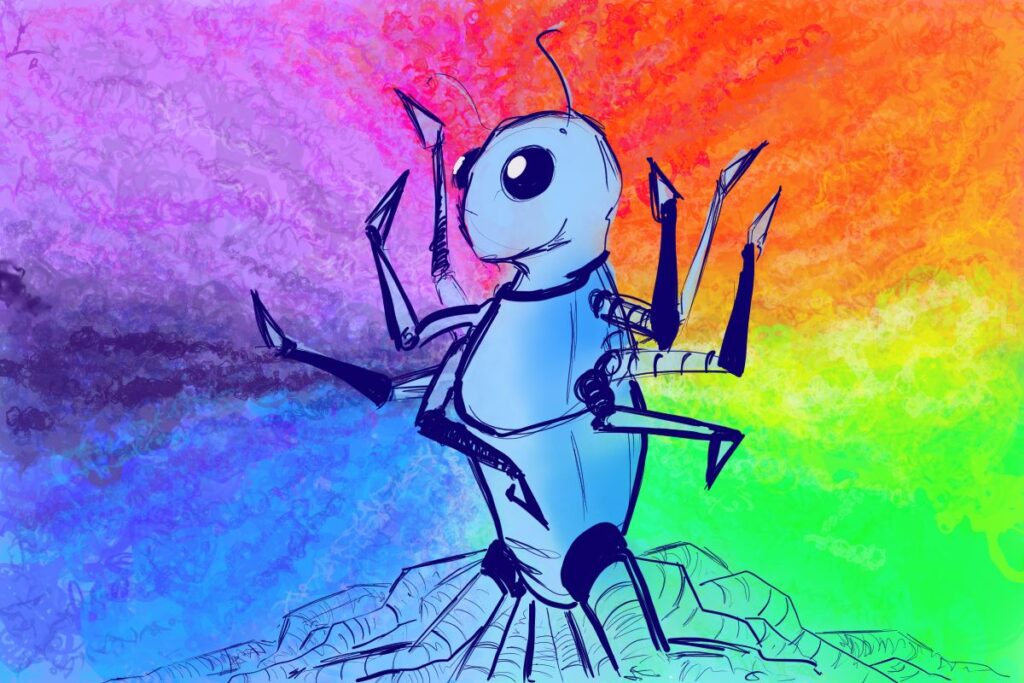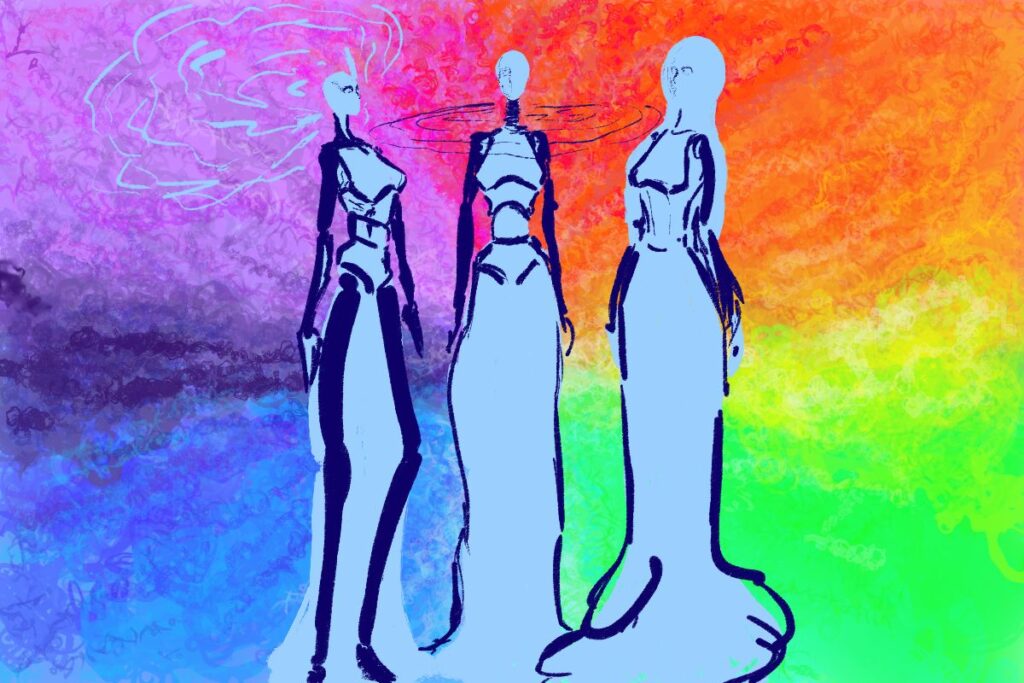
- How will Drawing help you Write better?
- How to learn the Basics?
- In a week?
- In a month?
- What are the Basics?
- What do you need to know in order to Write better?
Fundamentals
- Clarity
- Represent objects with clear Colors.
- Represent objects with simple Forms.
- A proper drawing, aim to be comprehensible.
- Each part should be identifiable.
- Aim for Contrast.
- Components
- Which Features define your World?
- What do you need to Draw?
- Which References will you Use?
- Creatures
- Which Kind of People inhabit your World?
- Which Kind of Animals?
- Which Kind of Plants?
- How do you Represent them?
- Icons
- Which Symbols do you use?
- Which Iconography do you use?
- Which Forms do you use?
- Which Shapes do you use?
Notebook
- Developing your Ideas
- Keeping a Notebook by your Side is the easiest way to develop your Ideas.
- It may also be the most enjoyable too.
- The Notebook can welcome your Sketches, your handwritten texts, your notes.
- You can comment your Drawings.
- Maybe you’ll even want to use them as Illustrations for your Book.
- It helps developing the Basic design for your cover.
- Drawing will make your designs better.
- Especially if you keep them simple.
- Clearer Scenes
- How should a Scene be Written?
- How should a Scene be Drawn?
- Are these 2 questions different?
- To get a Clearer picture you must imagine it.
- How do you picture the Setting?
- How do you picture the Characters?
- How should the Character position themselves?
- Which Position should they adopt?
- How is it Displayed?
- Through which Expressions?
- Through which Gestures?
- Drawing will make your descriptions clearer.
- And your dialogues more dynamic.
- Taking a Break
- Do you need to pause?
- Would you Rest by Drawing?
- Free hand drawing would help your mind unfold.
- How so?
- Just by Drawing.
- What are you Drawing?
- A simple image.
- Does it have anything to do with your Story?
- It doesn’t have to.
- You could integrate it later.
- There are no results requirements here.
Heads
- Structure – Head types
- You’ll need at least 4 different Head types.
- 4 different Sizes.
- 4 different Forms.
- Start with simple Forms.
- A Cube, a Sphere, a Trapeze or a Pyramid.
- From there carve the details.
- You’ll refine the forms to Characterize.
- How is the Character’s Head?
- What should it display?
- What should be the 1st impression?
- Anatomy – Characters
- Anatomy comes on top of the Structure.
- It is a 2nd Layer of Specificity.
- Anatomy is used to define your Character’s special Characteristics.
- How should her skull Structure be?
- What are her Muscular-Skeletal Characteristics?
- What is her Maxillofacial profile?
- Which Features define your Characters?
- How’s her Nose?
- How’s her Mouth?
- How are her Eyes?
- How are her Ears?
- How are her Cheekbones?
- What should they Inspire?
- Quirks
- Which Expressions define the Character?
- Is she often Upset?
- How is it Displayed?
- Through her Eyes?
- Through her Mouth?
- Does she have special Ears?
- Do they change Color?
- Which Accessories does the Character wear on her head?
- Does she have a Head dress?
- How’s her Hairstyle?
- Does she wear Jewellery?
- Does she have piercings?
Bodies
- Structure – Body types
- You’ll need at least 4 different Body types.
- 4 different combinations of Sizes & Forms.
- The Lower & Upper parts of the Trunk are often harmoniously arranged.
- They can be.
- They do not have to be.
- How should you arrange the Thorax & the Abdomen to create contrast?
- Which Sizes should they be?
- Which Forms should they be?
- This is not the Anatomy part yet.
- The Structure part is far more permissive.
- It allows you to develop a sense of self for each Body type.
- You can use them as Body Archetypes.
- Which Kind of
- How is the Character’s Body?
- How is her Silhouette?
- How Memorable is it?
- How does she look from Front?
- How does she look from Side?
- How does she look from Back?
- What should it Reveal?
- What should it Inspire?
- Anatomy – Characters
- How should you Draw the Character?
- How will you make her look Unique?
- Which Features would make her Unique?
- It allows you to develop a sense of self for each Character.
- How does the Character look like on the Surface?
- How’s her Skin?
- Does it have any peculiarities?
- Is she Tattooed?
- Is she Freckled?
- Does she have Scars?
- How is her Hair?
- How dense is it?
- How thick is it?
- How long?
- How are her Muscles?
- Is she Athletic?
- Is she Slender?
- Is she Thick?
- What should the Character exude?
- How does her Anatomy convey this emotion?
- Which emotion is it supposed to be?
- Quirks
- How does the Character Pose?
- What are her signature Poses?
- Which Accessories does she wear?
- How do they embellish her body?
- Which Accessories are missing?
- Which Clothes should she wear?
- How do they her compliment her Forms?
- How is the Drapery drawn?
- Which material is used?
- Which textures are used?
Hands & Feet
- Structure – Animality
- How can you turn a Hand into something else?
- How can you reveal the Mechanical nature of the hand?
- How would you use its Size?
- How would you modify its Form?
- Have you ever thought about drawing hands as if they were animals?
- Have you ever thought about drawing hands as if they were animal parts?
- The most obvious would be Claws.
- Have you though of a hand as a Mouth?
- As Jaws?
- Arms as Horns?
- Arms as Tentacles?
- Can you draw Hands as Animals?
- How can you make Hands & Feet more alive?
- Anatomy – Limbs
- Features
- How would you draw her Limbs?
- How many should she have?
- Which type?
- How Long are her Limbs?
- How Thick are her Limbs?
- How Soft are her Limbs?
- How are they Shaped?
- How are they Covered?
- With which kind of Skin?
- Does she have an Exoskeleton?
- Does she have Wings?
- Does she Tail?
- Does she have any Limbs?
- Why?
- How did it happen?
- Is she born this way?
- Did she have an accident?
- Which Crisis did she have to face?
- Quirks
- How do the Character’s Hands & Feet behave?
- How do they display her Emotions?
- How can you display Expressions through Hands?
- How can you display Expressions through Feet?
- They can display Anger or Joy quite easily.
- What about Sadness?
- Fear?
- Is it so easy?
- Is it so obvious?
- How do Hands characterize someone?
- How do Feet characterize someone?
- Do they transcribe her Habits?
- Do they transcribe her Anxiety?
- Do they transcribe her Willpower?
- Manifestations
- Through which Gestures?
- Accessories
Compositions
- Use of Space
- What is your Frame?
- What is your Setting?
- How will you use Framing to embellish your Setting?
- What is your Main Subject?
- Is it a Character?
- Who is it?
- How is she depicted?
- How do you reinforce Attention on her?
- How do you create Focus?
- On what is the attention Focalized?
- What are the Fundamental elements of the Picture?
- How clearly are they displayed?
- What could reinforce this Clarity?
- Forms, Shapes & Depth
- What are the Main Shapes used?
- What are the building Blocks of your Pictures?
- How do you delimit the space of each Block?
- How do you turn Shapes into Forms?
- What should look 3-dimensional?
- What should look 2-dimensional?
- How do you convey perspective?
- Which Forms create a sense of Depth?
- Which Shapes flatten the picture?
- Light
- Does your picture have Colors?
- Textures
- Which Atmosphere is conveyed?
- Which Colors are used?
- How are they arranged?
- Where are you?
- What are the dominant Colors?
- How do they complement each other?
- What are the most common forms?
- What is their respective Color?
- How do they define the Environment?
- How does light lifts the Colors?
- How does light alter Forms?
- How does light affect Behaviors?
- How do Colors affect Behaviors?
- How do forms affect the perception of the Environment?
- Thematic Contrast
- What are the Fundamental Themes of your Story?
- Which Themes are depicted in this Picture?
- How do they Relate to each other?
- Do they oppose each other?
- Do they complement each other?
- Which Relationships between the Character do they Reveal?
- Does every Character represent a Theme?
- Which Theme do they represent?
- What does this Suggest?
How to Compose easily?
- Using the rule of Thirds is the easiest approach.
- Separate your picture in 9 sections.
- Choose the Section in which your main Subject will be placed.
- Focus the rest of your image to this Subject using basic Perspective.
